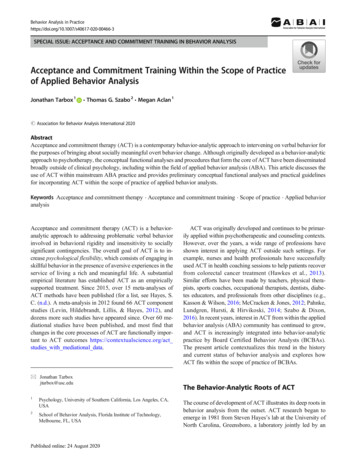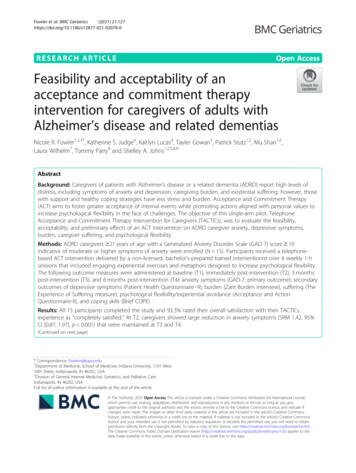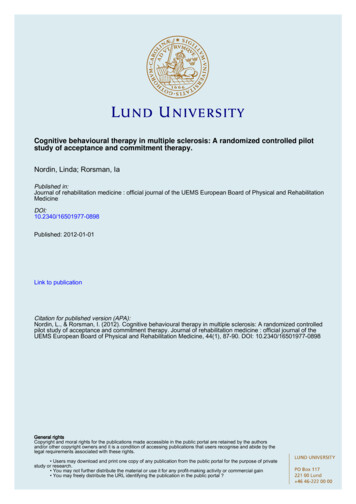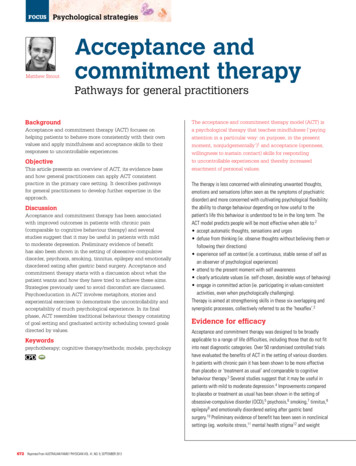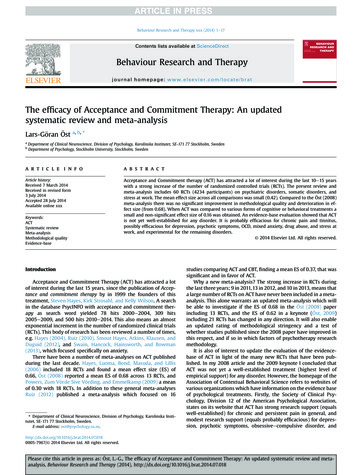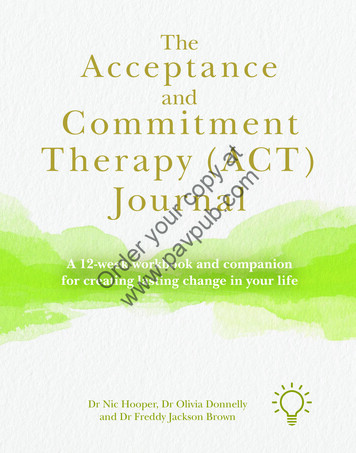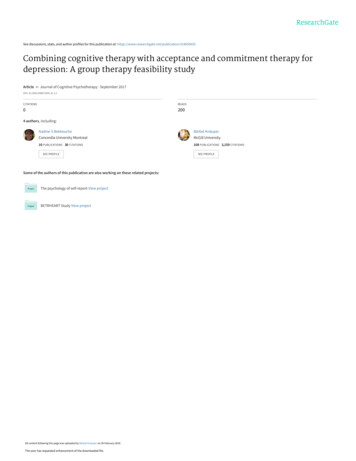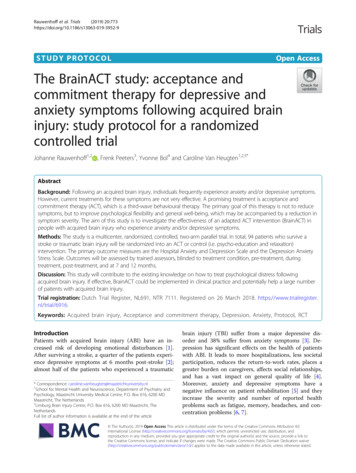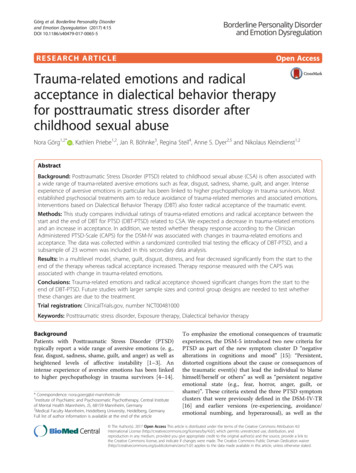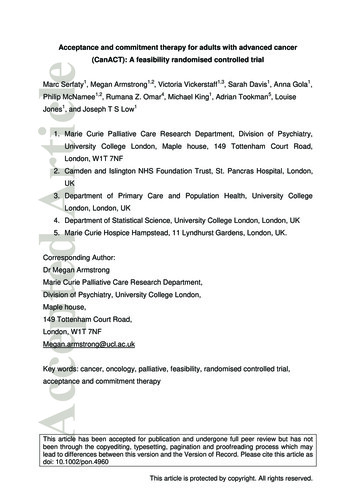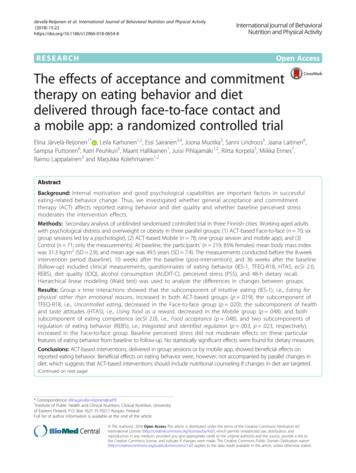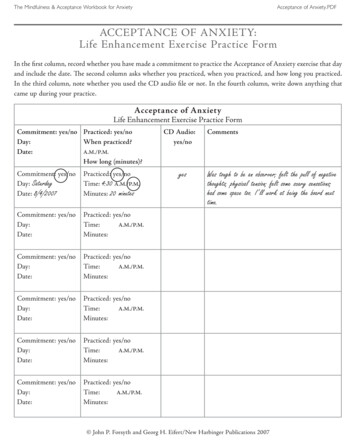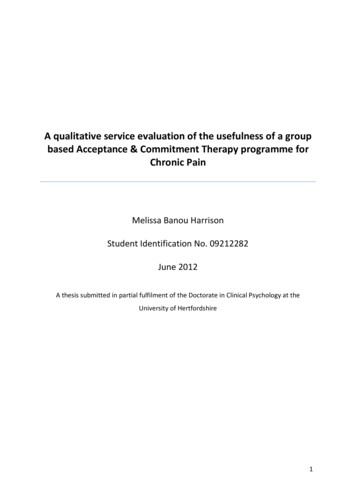
Transcription
A qualitative service evaluation of the usefulness of a groupbased Acceptance & Commitment Therapy programme forChronic PainMelissa Banou HarrisonStudent Identification No. 09212282June 2012A thesis submitted in partial fulfilment of the Doctorate in Clinical Psychology at theUniversity of Hertfordshire1
ACKNOWLEDGEMENTSI would like to thank all the participants who shared their experiences with me in thisresearch study and it is my hope that their honesty will benefit others. I would also like tothank Joerg Schulz, Dr Saskia Keville and Dr Greg Wood for their continuous support,direction and encouragement throughout this process.I am eternally grateful to my loving mother for her support and presence over the past threeyears in particular, and without whom clinical training wouldn’t have been possible. Thankyou to my dear family and friends for their patience and understanding and for alwaysbelieving in me, and to cohort 9 for sharing this journey.Finally, I wish to dedicate this thesis to my dearest husband and son-you are both always bymy side and are my reason to keep on going.2
Table of ContentsBackground . 10Aim . 10Methodology. 10Results . 11Clinical Implications & Conclusion . 111.1.Overview . 121.2.Literature Search Strategy. 12The Serenity Prayer . 131.3.Statement of Position. 131.4.How I Came to this Study? . 131.5.Understanding Acceptance . 141.6.What is Pain? . 151.6.1.1.7.Prevalence rates and impact of chronic pain . 16Psychological Factors of Pain . 171.7.1.Beliefs . 171.7.2.Self-efficacy . 181.7.3.Stress . 191.7.4.Adjustment. 201.7.5.Locus of control. 211.8.Health Care Seeking Behaviour . 211.9.Treatments for CP . 221.9.1.Traditional medical interventions . 221.9.2.A biopsychosocial approach . 231.9.3.Pain management programmes (PMPs) . 253
1.10.Psychologically Oriented Treatment Approaches . 271.10.1.Cognitive Behavioural Therapy . 271.10.2.Third wave approaches . 291.11.Acceptance and Commitment Therapy (ACT) . 291.12.ACT Philosophy . 311.12.1.Conceptual and theoretical underpinnings. 311.12.2.The model of change underlying ACT . 331.13.Empirical Support for ACT . 371.14.How does ACT compare to other therapies for chronic pain? . 381.14.1.Empirical considerations . 391.15.Luton & Dunstable Hospital ACT programme for chronic pain . 401.16.Rationale for this Study . 441.17.Aim . 452.1.Overview . 462.2.Design . 462.3.Epistemological Positioning . 472.3.1.Dominant traditional perspective – positivism and quantitative methods . 472.3.2.The emergence of an alternative perspective – relativism and qualitativemethods . 472.4.Why a Qualitative Approach? . 482.5.Rationale for Semi-Structured Interviews. 492.6.Reasons for Using Thematic Analysis . 492.7.Other Qualitative Methods . 502.8.Study Development . 502.9.Interview Design. 512.10.Ethical Issues . 514
2.10.1.Informed consent . 512.10.2.Confidentiality . 522.10.3.Distress . 522.10.4.Further considerations . 532.11.Procedure and Data Collection . 532.11.1.Context of the service . 532.11.2.Participants. 542.11.3.Sampling method . 552.11.4.Flow chart . 562.11.5.Sample of participants information . 562.11.6.Interviews . 572.12.Data Analysis. 582.13.Thematic Analysis Procedure . 592.13.1.Stage One: familiarisation with the data . 592.13.2.Stage Two: generating initial codes . 592.13.3.Stage Three: searching for themes . 602.14.Thematic Networks. 602.15.Providing Credibility Checks . 613.1.Overview . 633.2.Thematic Network Analysis Stage 1: From Codes to Themes. 633.3.Thematic Network Analysis Stage 2: From Basic to Organising Themes . 643.4.Organising Theme 1: HOPE . 673.4.1.“The last resort” . 673.4.2.“Receiving validation” . 683.5.Organising Theme 2: HOPELESSNESS . 683.5.1.“When all else has failed” . 685
3.5.2.“Scepticism” . 693.5.3.“Feeling misunderstood” . 703.5.4.“Being invisible” . 703.5.5.“Desperation” . 713.6.Organising Theme 3: Benefits of Acceptance . 723.6.1.“I am not my pain ” . 723.6.2.“Adjusting expectations” . 733.6.3.Being in the present . 743.6.4.“Giving up the fight” . 753.6.5.“Willingness to try” . 763.7.Organising Theme 4: Barriers to Acceptance . 773.7.1.“Fight with pain” . 773.7.2.“Cycles of emotions”. 783.7.3.“Societal attitudes” . 793.7.4.“Timing issues”. 803.7.5.“Employment issues” . 803.7.6.“Struggles with being in the present” . 813.7.7.“Language - changing the name of the programme” . 823.8.Organising Theme 5: Positive Experience of Group . 833.8.1.“Understanding” . 833.8.2.“Mutual support” . 843.8.3.“Increase confidence” . 853.9.Organising Theme 6: Negative Experience of Group . 863.9.1.“De-personalisation”. 863.9.2.“Seeing others in pain” . 873.9.3.“Intimidation” . 876
3.10.Constructing the Networks: Identification of Global Themes . 883.10.1.Global Theme 1: Pre-programme Expectations . 903.10.2.Global Theme 2: Living with pain: outlook on problems . 913.10.3.Global Theme 3: Experience of group setting . 924.1.Pre-Programme Expectations - Hope vs. Hopelessness . 944.1.1.What factors contribute to a sense of hopelessness? . 944.1.2.What does it mean to have CP for the individual with CP? . 964.1.3.What is the impact of others perceptions of CP? . 974.2.Living with Pain - Benefits of Acceptance vs. Barriers to Acceptance . 984.2.1.The process of acceptance . 994.2.2.What factors contribute to the process of acceptance? . 1004.2.3.Why can some people accept and others can’t? . 1014.2.4.Issues of timing . 1024.2.5.Living with uncertainty . 1034.2.6.The pain battle . 1044.2.7.Struggles with language . 1064.2.8.The stigmatisation of CP . 1074.3.Experience of Group Setting - Positive vs. Negative . 1094.3.1.What are the positive aspects of being in a group setting? . 1094.3.2.The challenges of being in a group setting . 1104.3.3.The effectiveness of a group based ACT programme for CP . 1104.4.Implications for Clinical Practice . 1124.5.Methodological Considerations . 1154.5.1.Reflexivity . 1164.5.2.Validity and reliability checks . 1174.6.Limitations and Future Research . 1177
APPENDIX 1: Session Plans for Luton & Dunstable ACT programme for Chronic Pain . 153APPENDIX 2: Interview Schedule for Semi-Structured Interviews . 155APPENDIX 3: Letter from NHS Health Research Authority . 156APPENDIX 4: Letter from Luton and Dunstable Hospital. 160APPENDIX 5: Participant Information Sheet . 161APPENDIX 6: Reply Slip for Participants. 166APPENDIX 7: Informed Consent Form . 167APPENDIX 8: Transcription Confidentiality Agreement . 169APPENDIX 9: Example of Interview Transcript . 170APPENDIX 10: Thematic Network Analysis-Stage 1 . 180APPENDIX 11: Thematic Network Analysis-Stage 2 . 184Figure 1: The ACT hexagonal model of change (Hayes et al., 2006). . 34Figure 2: The ACT hexagonal model of change divided into two parts (Hayes & Strosahl,2010). . 37Figure 3: Desired outcomes for the Luton & Dunstable ACT programme for CP . 42Figure 4: The control and avoidance cycle which is often experienced by people with CP. 42Table 1: Table of Participant Information . 57Table 2: Organising and Basic Themes from analysis of 12 interviews . 66Table 3: Quotations from participant’s about the basic theme “the last resort” . 67Table 4: Quotations from the participants in relation to the basic theme “receivingvalidation” . 68Table 5: Quotations from participants reflecting the basic theme “when all else has failed”69Table 6: Quotations from participants reflecting the basic theme of “scepticism” . 698
Table 7: Quotations from participants reflecting the basic theme of “feeling misunderstood”. 70Table 8: Quotations from participants reflecting the basic theme of “feeling invisible” . 71Table 9: Quotations from participants, reflecting the basic theme “desperation” . 72Table 10: Quotations reflecting the basic theme “I am not my pain” . 73Table 11: Quotations from participants reflecting the basic theme “adjusting expectations”. 73Table 12: Quotations from participants reflecting the basic theme “being in the present” . 74Table 13: Quotations from participants reflecting the basic theme “giving up the fight” . 75Table 14: Quotations from participants reflecting the basic theme “willingness to try” . 76Table 15: Quotations from participants reflecting the basic theme “fight with pain” . 77Table 16: Quotations from participants reflecting the basic theme “cycle of emotions” . 78Table 17: Quotations from participants reflecting the basic theme “societal attitudes” . 79Table 18: Quotations from participants reflecting the basic theme “timing issues” . 80Table 19: Quotations from participants reflecting the basic theme “employment issues”. 81Table 20: Quotations from participants reflecting the basic theme “struggles with being inthe present” . 82Table 21: Quotations from participants reflecting the basic theme “language” . 82Table 22: Quotations from participants reflecting the basic theme “understanding” . 83Table 23: Quotations from participants reflecting the basic theme of “mutual support” . 84Table 24: Quotations from participants reflecting the basic theme “increase confidence”. 85Table 25: Quotations from participants reflecting the basic theme “de-personalisation”. 86Table 26: Quotations from participants reflecting the basic theme “seeing others in pain” . 87Table 27: Quotations reflecting the basic theme “intimidation” . 88Table 28: The three global themes, six organising themes and 24 basic themes which werefound to be representative of the data . 899
ABSTRACTBackgroundIn recent years Acceptance and Commitment Therapy (ACT) has gained increasing status as apromising approach to treating chronic pain physical functioning and psychological wellbeing. The basic premise of ACT as applied to chronic pain is that while pain hurts, it is thestruggle with pain that causes suffering. This approach aims to restore effective andadaptive functioning for an individual within a context of continuing pain so that theindividual can live a more vital and meaningful life.There is a growing empirical support for the effectiveness of ACT however research hasrelied on self-reported quantitative outcomes, focused on addressing changes in painintensity and the physical and psychological impact of chronic pain. There appears to be agap in the literature on the exploration of the experience of attending an ACT programmefor chronic pain from the patient’s perspective.AimThis study sought to explore the experience of attending an ACT programme for chronicpain within an outpatient NHS hospital setting. Furthermore the study sought to explore themodulating factors influencing clients learning and understanding of the construct ofacceptance from the perspective of the participants. Additionally, the experience ofattending a group based ACT intervention was explored.MethodologyA qualitative methodology was chosen for the project. The study used a purposive sample oftwelve participants, who had all attended the Luton & Dunstable Hospital ACT 8 weekoutpatient programme for chronic pain. The participants were interviewed through the useof a semi structured interviews, and the transcripts were transcribed and then analysedusing Thematic Analysis. Identified themes were further organised using the tool ofThematic Network Analysis.10
ResultsThree global themes emerged from the analysis of the data. The first global themeencompassed the participant’s pre-programme expectations and this theme highlighted theparticipant’s feelings of hope and hopelessness prior to attending the programme. Thesecond global theme demonstrated the on-going process of living with chronic pain andhighlighted the benefits and barriers to adopting and ACT based approach to chronic pain.Finally the third global theme addressed the experience of a group based intervention andincluded the positive and negative aspects of this experience for the participants.Clinical Implications & ConclusionBased on the results of this study a number of clinical implications were highlighted inrelation to the future development of ACT programmes for chronic pain. These includedsuggestions in relation to engaging participants in such programmes. Notably, timing issues,validation of physical symptoms, and consideration of the potential barriers to acceptanceand understanding of the benefits of adopting and ACT group based pain managementapproach were discussed.11
CHAPTER 1 - INTRODUCTION1.1.OverviewThe introduction to this study first orients the reader to the position of the researcher andwhy this topic area was chosen. The concepts of pain and chronic pain are presented andsome key psychological factors related to chronic pain are outlined. This is followed by anintroduction to the treatments for chronic pain including some of the theoreticalunderpinnings of these treatment approaches. There is a vast amount of literature availableon the treatments for chronic pain and a full review of its entirety is beyond the scope ofthis project. An overview of the Acceptance and Commitment Therapy (ACT) approach tochronic pain is provided followed by an introduction to the key concepts within the ACTphilosophy. A review of the empirical evidence for ACT for chronic pain discusses thefindings of quantitative outcome studies and makes enquiries about the need for aqualitative understanding of the experience of adopting an ACT approach to chronic painmanagement, which appears to be limited in the literature. Finally the rationale for thisstudy and its clinical relevance and aims are outlined.1.2.Literature Search StrategyIdentifying relevant information was an on-going and iterative process. A systematicliterature search was conducted over a period of 12 months, in order to ensure thoroughcoverage and reduce the potential for bias within selected literature. In summary, thepreliminary stage focused on a limited set of key terms (e.g. Chronic Pain; Acceptance andCommitment Therapy (ACT); pain management programmes; CBT, Mindfulness BasedCognitive Therapy, Contextual Cognitive Behavioural Therapy), in the databases Psych Info,PubMed, Medline, Scopus, Web of Science, Science Direct and Google Scholar. Referencesfrom generated articles were followed up and a list of relevant key search terms developed,alongside additional inclusion and exclusion criteria. Researchers in the field were contactedto source further references if articles were not accessible freely on the internet (for12
example, articles in submission or in press). An additional literature search was carried outfollowing initial stages of analysis to explore areas that had arisen, and search terms wereexpanded to incorporate these.The Serenity PrayerGod grant me the serenityto accept the things I cannot change;courage to change the things I can;and wisdom to know the difference.--Reinhold Niebuhr1.3.Statement of PositionSelf-reflection allows a researcher to acknowledge their own values and existing theory inorder to more adequately represent the experiences of their participants (Elliott, Fischer,and Rennie, 1999). Additionally, the importance of “owning one’s perspective” is wellrecognised in the development of good qualitative research. Whilst qualitative researchersaccept that it is not possible to set aside their own beliefs, values and perspectivesthroughout the process (Webb, 1992), by being transparent, my aim is that the reader willrecognise both the personal and theoretical position underpinning this study.1.4.How I Came to this Study?In many ways this research study chose me. I initially started clinical training five years ago,however following a near- fatal car accident during my first term, I was left with significantphysical injuries which forced me to temporarily terminate my chosen career path andundergo a rehabilitative process which was to change my life forever. During this time Ibattled with pain, on many levels, and although the physical scars healed, the emotionalstruggles and pain continued.13
I am now in the position whereby I am able to look back over the past five years and reflecton the changes I have faced. I have been blessed with a son, and am now nearing the end oftraining. My choice of research topic therefore seemed an obvious one, as my journey thisfar has been full of challenges; however, by accepting and maintaining a commitment tomyself and my family I have been able to live my life despite chronic pain.My experiences throughout Clinical Psychology training and previous employment inconjunction with my personal values and experience have led me to favour socialconstructionist and constructivist ideas in research. Pain can mean so many things, to somany different people, and the experience of pain is essentially an individual, internalexperience, known only to the person in pain (Davis, 2000).1.5.Understanding AcceptanceAcceptance does not imply a blind pursuit of activity and uncompromised lifestyle in spite ofpain, but features behaving in chosen ways with pain, thus achieving a full and satisfying life(McCracken, 2005a). Acceptance acknowledges pain, and suggests that pain has beenincorporated into a person’s life and that life could be lived regardless of pain.The research questions posed within this study grew from an interest in the response ofindividuals with chronic pain to this alternative approach to managing chronic illness.Current pain management interventions are based on the accepted pain paradigm that“pain is an unpleasant sensory and emotional experience associated with actual or potentialtissue damage” (IASP, 1994). However although this definition acknowledges that there isan emotional component to pain, it says nothing of how emotion fits and/or interacts intothe individual experience of pain. It also fails to convey the way pain shifts and changes thelandscape of a person’s world.Chronic pain changes the foundations of a person’s life, because the pain creates new andqualitatively different life conditions. In my final year of training I have chosen to work in anoutpatient pain clinic, and this experience has provided me with an insight into the way thatpain can affect the every aspect of being-physical, social, psychological, financial and even14
spiritual. Some people
In recent years Acceptance and Commitment Therapy (ACT) has gained increasing status as a promising approach to treating chronic pain physical functioning and psychological well-being. The basic premise of ACT as applied to chronic pain is that while pain hurts, it is the struggle with pain that causes suffering.
